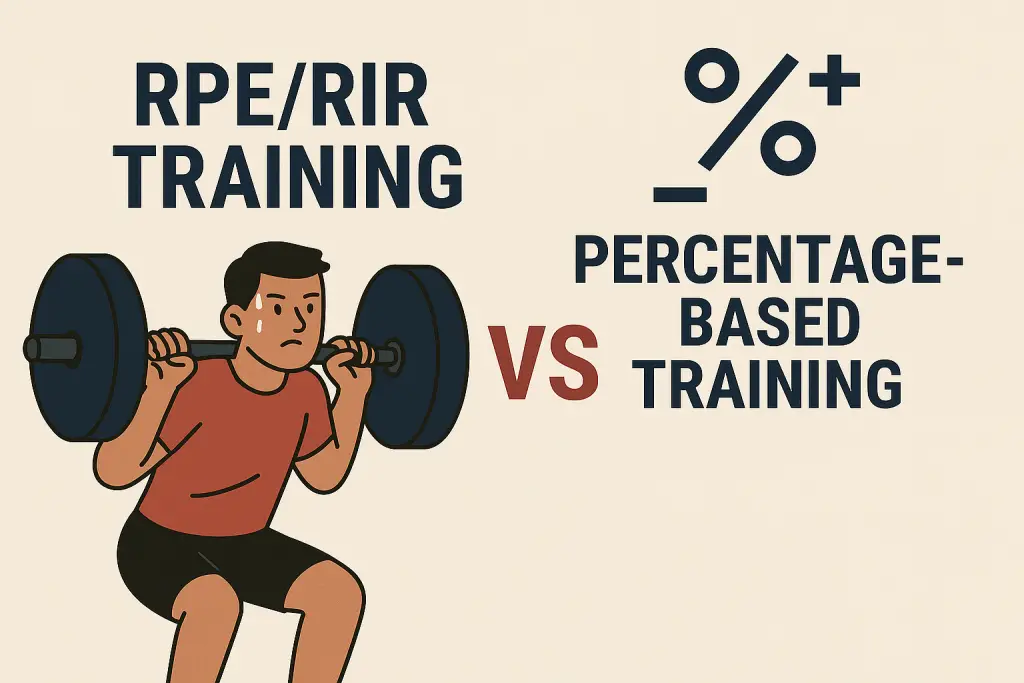RPE vs Percentage-Based Training: Which Is Right for You?

If you’re trying to build strength or size, one of the biggest questions you’ll face is:
Should I train based on percentages… or use RPE (Rate of Perceived Exertion) or RIR (Reps in Reserve)?
Both methods have their place. Both are backed by science. But they come with different advantages — and knowing when to use each can help you train smarter and progress faster.
Let’s break it all down.
What Is RPE/RIR Training?
RPE (Rate of Perceived Exertion) is a scale from 1 to 10 that helps you rate how hard a set feels:
- RPE 10 = Max effort (no reps left)
- RPE 8 = 2 reps in reserve
- RPE 6 = Light effort
RIR (Reps in Reserve) is the reverse: it directly estimates how many reps you had left. They’re essentially interchangeable:
| RPE | RIR | Meaning |
|---|---|---|
| 10 | 0 | No reps left (failure) |
| 9 | 1 | One rep left |
| 8 | 2 | Two reps left |
This method is subjective — you adjust load based on how you feel.
What Is Percentage-Based Training?
Percentage-based training programs calculate your working weights based on your 1-rep max (1RM).
Example:
- Your 1RM bench press is 250 lbs
- A workout calls for 5 reps at 80%
- You lift 200 lbs, regardless of how it feels that day
It’s objective and predictable — but not always flexible.
RPE vs Percentage-Based Training: Key Differences
| Feature | RPE / RIR | Percentage-Based |
|---|---|---|
| Adjusts to fatigue | Yes | No |
| Requires max testing | No | Yes |
| Good for beginners | Yes (with guidance) | Yes (simple to follow) |
| Auto-regulated | Yes | No |
| Individualized load | Yes | No |
| Trackable progression | Yes | Yes |
| Program structure | Flexible | Highly structured |
Pros of RPE / RIR Training
- Adapts to real-life stress: You can push harder on good days and back off on rough ones.
- Avoids burnout: No need to force heavy lifts on bad recovery days.
- Teaches effort awareness: Great for building lifter intuition and longevity.
- No testing required: Perfect for beginners or during hypertrophy blocks.
Cons of RPE / RIR Training
- Requires experience: Beginners may under- or overestimate effort.
- Harder to program precisely: Especially in group or team settings.
- Less objective on paper: You need to track carefully to see long-term trends.
Pros of Percentage-Based Training
- Clear structure: Easy to follow with predefined weights.
- Objective: Great for seeing progression week-to-week.
- Ideal for peak performance: Helpful for powerlifting meet prep or strength cycles.
- Works well in group programs: Everyone trains to a standard.
Cons of Percentage-Based Training
- Doesn’t adjust to fatigue: If you’re tired, 80% might feel like 95%.
- Requires accurate 1RM: Testing too often can be risky and fatiguing.
- Can lead to overshooting: Especially if your true max has changed.
Which One Should You Use?
Use RPE/RIR when:
- You want flexibility in your training
- You’re recovering from illness, injury, or stress
- You’re focused on hypertrophy or general fitness
- You want to avoid unnecessary fatigue
Use Percentage-Based training when:
- You’re peaking for a meet or event
- You want a repeatable program across multiple lifters
- You’re in a block where fatigue is low and predictable
- You have an accurate, recent 1RM
Can You Combine Them?
Absolutely. Many programs use both:
- Program base sets using percentages
- Use RPE for top sets or backoff sets
- Add RIR ranges to coach effort within percentage zones (e.g., “3×8 @ 70% with 1-2 RIR”)
This hybrid approach gives you structure and flexibility.
Final Thoughts
There’s no one-size-fits-all answer. Both RPE/RIR and percentage-based training are powerful tools — when used intentionally.
For lifters who want adaptability, fatigue management, and auto-regulation, RPE and RIR are unbeatable.
For those who thrive on structure, objectivity, and linear progression, percentages still have a place.
Try both. Learn how your body responds. And don’t be afraid to evolve your training style over time.